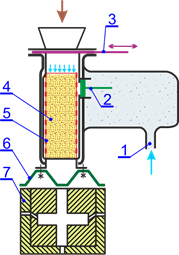In this method, compressed air is used for compaction similarly to blowing, but the principle (patent of 1949) differs. During the preparatory phase of the process, three processes take place simultaneously: 1) the core box, or the moulding box, is pushed up against the shooting head; 2) the moulding aggregate is metered into the shooting chamber of the shooting head; 3) the compressed air reservoir is pressurized while the shooting valve is closed. After the shooting valve is opened, the compaction is accomplished by the admission of a fixed volume of the compressed air from the machine reservoir to the shooting chamber through the shooting valve; the valve to the main air line is meanwhile kept closed. The effective aggregate propulsion results from the rapid expansion of the compressed air pressure build-up in the machine reservoir. The body of the shooting chamber comprises a perforated metal insert. The expanding air acts on the moulding aggregate from above, while also acting on the aggregate dose from the sides through the openings in the perforated metal insert. This creates an air cushion between the metal sheet insert and the aggregate, substantially of which reduces their friction, thus helping to rapidly accelerate the dose of the aggregate. Moreover, the air acting from the sides fluidizes the moulding aggregate. The shooting process is very short; the entire volume of the moulding aggregate dose is transferred from the shooting chamber to the core box or moulding box in a fraction of a second. The air from the core box or moulding box escapes during shooting through air vents. Of great importance is the conical end of the shooting port, which causes the moulding aggregate to be pre-compacted right in the shooting head. Instead of a carrying function in the case of blowing, the compressed air takes an accelerating function.

Core shooting;
1 – compressed air inlet, 2 – shooting valve, 3 – dosing slide, 4 – feed moulding
aggregate, 5 – perforated metal insert, 6 – pre-compacting shield, 7 – core box